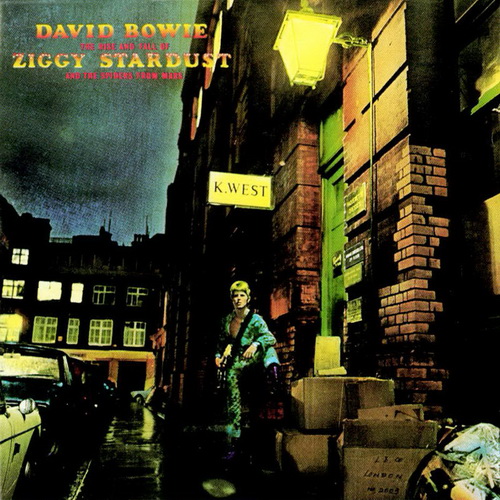Great Covers: Ziggy Stardust (1972)
[To mark the passing of David Bowie, I repost this from October 2013]
There is a sweet irony in the cover picture of The Rise and Fall of Ziggy Stardust and the Spiders from Mars: the alien superstar is photographed in a seedy sidestreet, not a glittering glamour spot, of London’s West End. Instead of shining brightly in a metallic science fiction wonderland, the monochrome photo is hand-coloured in the way of postcards from the turn of the last century.
The cover holds not the promise of the story we are coming to hear, but its denouement: Ziggy has come back down to earth as David Bowie. There’s trash, there’s rain, there’s a bin, there’s the sign of the furrier K. West, where the fiction of left-handed Ziggy and the fact of Bowie, holding his guitar right-handed, come together.
Or that’s how I choose to see it. The story of Ziggy Stardust is vague enough to let you project your own ideas on it. In fact, by writing about the cover, by stripping away a veneer of its mystique, I may be depriving you, if you do not know the story of the cover, of your ability to freely project. Read on at your own peril.
What we will find is that the story of the cover is rather… ordinary. The photo was taken on a cold January night in 1972 in Soho’s Heddon Street, then an insalubrious sidestreet, but today a fashionable pedestrian zone. The photographer was Brian Ward, who had studio in the street.
He took 17 photos that night, including the back cover shot of Ziggy/Bowie in the telephone booth. The front cover pic was taken at house number 23, under the big sign for K. West. Apparently Bowie turned up (with a posse of two girls), posed for a few minutes, and quickly disappeared into the rainy night, leaving Ward to develop his black-and-white photos.
Did Bowie feel like Ziggy in “Five Years”? “It was cold and it rained and I felt like an actor.”
 The winning shot was colourised, giving the jumpsuit a blue hue when it was, in fact, green. You can see the jumpsuit in real life on this clip from the Old Grey Whistle Test in February 1972.
The winning shot was colourised, giving the jumpsuit a blue hue when it was, in fact, green. You can see the jumpsuit in real life on this clip from the Old Grey Whistle Test in February 1972.
Have look at all 17 photos of the session at the Five Years site (from which I’ve borrowed one here). And if you feel that Bowie was wrong as Ziggy, and it should have been your mug on the cover, well, that can be arranged HERE.
As for the signs on the wall? They were for Paquerette Dresses (4th Floor), Ramar Dresses Ltd (3rd Floor), International Wool Secretariat, Cravats Ltd (main entrance), and T.H. Ferris (2nd Floor)
So, to mark the Ziggy cover here’s a mix of Ziggy covers. Every track off the album is performed in sequence by various artists — and two by Bowie. One is from the famous Hammersmith Odeon concert at which he killed off Ziggy Stardust — obviously the final track, “Rock ’n’ Roll Suicide” — the other a new mix of the largely uncovered “Star”. In fact, there’s a third Bowie number: The Arnold Corns was a Bowie project on which he test-drove some Ziggy tracks a year before he gave birth to the alien superstar.
One song on the album, of course, was a cover itself: “It Ain’t Easy” was a Ron Davies song. The cover of that on this mix also precedes Ziggy.
1. The Polyphonic Spree – Five Years (2002)
2. Marti Jones – Soul Love (1986)
3. The Arnold Corns – Moonage Daydream (1971)
4. Leningrad Cowboys – Starman (2006)
5. Three Dog Night – It Ain’t Easy (1970)
6. Seu Jorge – Lady Stardust (2005)
7. David Bowie – Star (40th Anniversary Mix) (1972/2012)
8. Contraband – Hang On To Yourself (1991)
9. Bauhaus – Ziggy Stardust (1982)
10. Red Hot Chili Peppers – Suffragette City (2012)
11. David Bowie – Rock ‘n’ Roll Suicide (live) (1973)
GET IT!
(PW in comments)
…

















Recent Comments